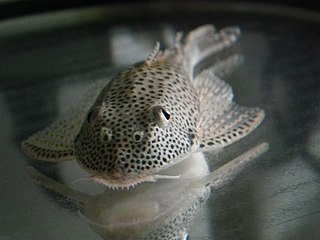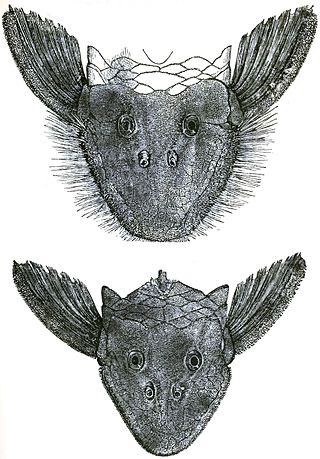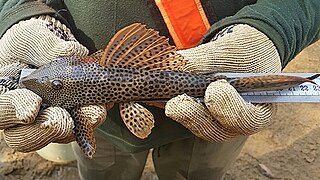
Ancistrus is a genus of nocturnal freshwater fish in the family Loricariidae of order Siluriformes, native to freshwater habitats in South America and Panama. Fish of this genus are common in the aquarium trade where they are known as bushynose or bristlenose catfish. In the aquarium hobby they are often referred to as bushynose or bristlenose plecos instead, but this may lead to confusion as "pleco" usually is used for Hypostomus plecostomus and its allies and is often used as a catchall term for any loricariids remotely resembling that species.

Loricariidae is the largest family of catfish, with 92 genera and just over 680 species. Loricariids originate from freshwater habitats of Costa Rica, Panama, and tropical and subtropical South America. These fish are noted for the bony plates covering their bodies and their suckermouths. Several genera are sold as "plecos", notably the suckermouth catfish, Hypostomus plecostomus, and are popular as aquarium fish.

Hypostomus is a genus of catfish in the family Loricariidae. They are native to tropical and subtropical South America. H. plecostomus is the popular freshwater aquarium fish formerly known as Plecostomus plecostomus. The taxonomic structure of the Loricariidae is still being expanded by scientists. Hypostomus is a highly species-rich and widely distributed catfish genus.

Pterygoplichthys, sometimes collectively known as janitor fish, is a genus of South American armored catfishes. These fish are commonly known as sailfin armoured catfish or sailfin plecs, especially in the aquarium trade.

Aphanotorulus is a genus of armored catfishes native to the Amazon, Orinoco, Essequibo and Jaguaribe basins in South America. They typically occur on a sand or gravel bottom in slow to moderately flowing rivers and streams, but some species occur in areas with fast current. The largest species in the genus reaches up to 51 cm (20 in) in standard length.

Pseudancistrus is a genus of suckermouth armored catfishes native to South America.

Peckoltia is a genus of small South American armored suckermouth catfishes. Many of these fish are popular aquarium fish.

Isorineloricaria is a genus of catfish in the family Loricariidae from northwestern South America. They live in rivers and streams, typically with slow to moderately running water, in the Orinoco, Maracaibo, Magdalena and Guayas basins. The largest species in the genus reaches up to 52 cm (20 in) in standard length.

The Hypostominae are a subfamily of catfishes of the family Loricariidae. Most members are restricted to tropical and subtropical South America, but there are also several species in southern Central America. Hypostomus plecostomus, which is popular in the aquarium trade, has been introduced to several regions far from its native range.

Isorineloricaria spinosissima, also known as the zucchini catfish, is a species of Loricariidae endemic to the Guayas River basin in western Ecuador. This species grows to a length of 56.5 centimetres (22.2 in) TL.

Peckoltia sabaji is a species of catfish in the family Loricariidae. It is native to South America, where it occurs in the basins of the Rupununi, the Essequibo River, and the Takutu River in Guyana, as well as the basins of the Casiquiare canal, the Rio Negro, the Cinaruco River, and the Orinoco in Venezuela. It is usually found among boulders in medium to large rivers. The species reaches 19.8 cm SL and is of disputed classification.
Aphanotorulus ammophilus, also known as the black spotted pleco, is a species of benthopelagic tropical freshwater catfish in the family Loricariidae native to Venezuela and Colombia, specifically the Río Orinoco drainage. Due to an initial erroneous publication, A. ammophilus was initially placed into Hypostomus instead of Aphanotorulus. However, because this species shows sexual dimorphism, has a relatively flatter shape, and has a jagged posterior edge of its oral disc, it was placed in the genus Aphanotorulus. It sometimes appears in the aquarium trade, where it is known as the cute pleco, although it may be referred to by its L-numbers, L094 or L123. A. ammophilus reaches 16.1 cm (6.3 in) SL.

Aphanotorulus emarginatus is a species of catfish in the family Loricariidae. It is native to South America, where it occurs in the Amazon River basin. The species reaches 15 cm (5.9 in) in total length. It is known to be a facultative air-breather.
Aphanotorulus gomesi is a species of catfish in the family Loricariidae. It is native to South America, where it occurs in the Jaguaribe River basin. The species reaches 14.3 cm SL. It is thought to be a facultative air-breather.
Aphanotorulus horridus is a species of catfish in the family Loricariidae. It is native to South America, where it occurs in the Madeira River basin. The species reaches 35.5 cm SL. It is thought to be a facultative air-breather.
Aphanotorulus phrixosoma is a dubious species of catfish in the family Loricariidae. It is native to South America, where it occurs in the upper Amazon River basin. The species reaches 10.1 cm (4 in) SL. It is believed to be a facultative air-breather.
Aphanotorulus unicolor is a species of catfish in the family Loricariidae. It is native to South America, where it occurs in the upper Amazon River basin. The species reaches 13.9 cm SL.
Hypostomus aspidolepis is a species of catfish in the family Loricariidae that is of disputed taxonomic identity. It is a freshwater fish native to Central America, where it occurs in the Gatún River basin in the Caribbean coastal drainage of Panama. The species reaches 40 cm in standard length and is believed to be a facultative air-breather. Although originally described as a member of Chaetostomus by Albert Günther in 1867, it has subsequently been classified within Hypostomus, the now-invalid genus Plecostomus, and Hemiancistrus. A 2015 review conducted by Jonathan W. Armbruster, David C. Werneke, and Milton Tan recognized the species within Hypostomus, although sources such as FishBase, WoRMS and ITIS still consider it a member of Hemiancistrus.
Isorineloricaria acuarius is a species of catfish in the family Loricariidae. It is native to South America, where it occurs in the Apure River basin in Venezuela. The species reaches at least 26.9 cm (10.6 in) in standard length. It was described in 2016 as part of a taxonomic review of the genera Aphanotorulus and Isorineloricaria conducted by Jonathan W. Armbruster and C. Keith Ray.
Isorineloricaria villarsi is a species of catfish in the family Loricariidae. It is native to South America, where it is known only from Venezuela. The species reaches 32 cm in standard length and is believed to be a facultative air-breather.











